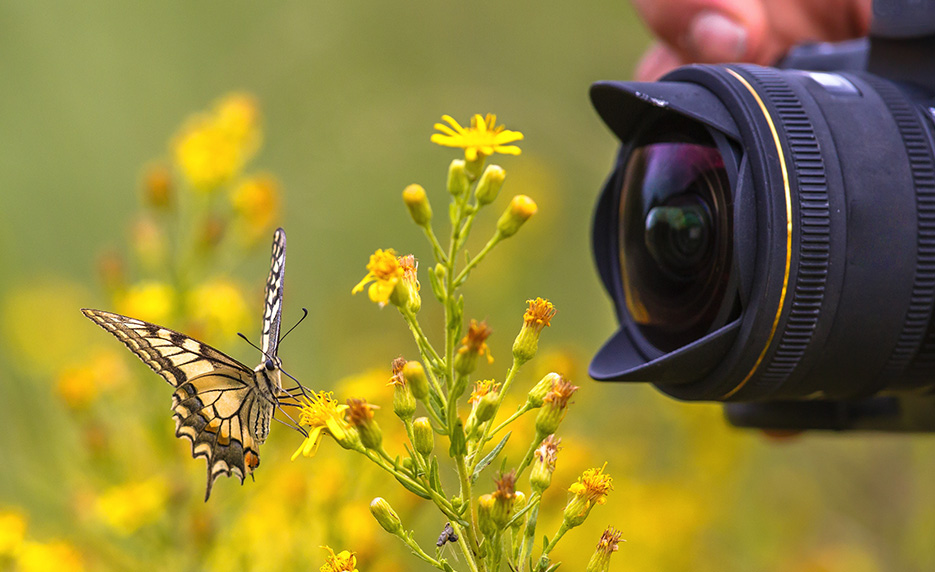The winners of the 2022 World Nature Photography Awards were announced on March 1, 2023. Jens Cullmann received the $1,000 grand prize for his photo of a barely visible, camouflaged crocodile peeking out of the mud in Mana Pools National Park in Zimbabwe. Winners were announced in 14 categories, including animals in their habitat, nature art, people and nature, underwater, and behavior-mammals.
Naturally, the photographers who took these shots are skilled and experienced with extensive knowledge of nature photography techniques and shooting styles. The following seven tips can help new and inexperienced photographers improve their abilities and capture more impactful and higher-quality images.
1. Use a Wide-Angle Lens
A wide-angle lens is arguably the most important piece of equipment you can have for nature photography, especially landscapes and close-ups of subjects. There are situations where you may need a telephoto lens to zoom in on faraway objects, i.e. shooting animals in the wild, but a wide-angle lens is generally preferred for most nature photos, as it offers a larger depth of field and captures more light because of the faster shutter speed. Some experienced photographers even suggest that you avoid using a telephoto lens if you want to become a better photographer.
“Ditch the zoom lens and learn to love the constraints of dealing with a fixed focal length, simply because the most important lens you own is your own legs,” notes Dutch photographer Pie Aerts. “Moving [your legs] instead of a zoom ring will instantly make you a better photographer. It increases the weight of your bag, but deal with it, it’s worth the pain. So, stop zooming, start seeing.”
2. Know the Rule of Thirds
The rule of thirds is especially important to keep in mind when shooting landscape photos because there is no immediate focal point. A composition technique to highlight points of interest and draw the viewer’s eyes to scan the entire frame, the rule of thirds states that all important elements of an image should intersect along a pair of equidistant horizontal and vertical lines, dividing the frame into nine equal parts. This is meant to create more tension and energy in a photo, while also balancing the image and showcasing wider landscapes and a more natural environment.
You can imagine these lines in your viewfinder, although some cameras have a grid camera mode that overlays the lines onto the screen to create nine congruent shapes.
3. Take Advantage of Natural Light
Lighting is one of the most important elements in capturing a great photo and, for landscape or other nature photos, there’s no better light than natural light from the sun or moon. This is why the best time to go out and shoot is either early in the morning or evening. The golden hours, one hour after sunrise and one hour prior to sunset, are the best times to capture photos with optimal natural lighting. This is because, during this time, the sun provides warm and soft lighting that’s easier to work with than the harsh midday sun. Subjects are also illuminated more evenly in the golden hours.
4. Use RAW Format
RAW format isn’t commonly used by inexperienced photographers, particularly those who shoot human subjects. As opposed to JPEG formatting, RAW images have substantially more pixels and, as a result, are sharper, more clear, and better for editing.
The downside to shooting in RAW is that it takes up much more space than a JPEG on your camera’s memory card, but this is a worthwhile trade-off if you’re trying to capture the perfect landscape photo. RAW files usually have between 12 to 14 bits per pixel, totaling 16,384 levels of brightness. In contrast, JPEG files have just 256 levels.
5. Study Nature
You can know everything there is to know about photography and different shooting techniques, but if you want the perfect nature photo you’re going to have to study nature. This is especially helpful for aspiring wildlife photographers. By understanding how animals move and interact with others, you’ll be more prepared to predict their next move and follow their rhythm. For example, if you know where a specific bird species typically performs its mating rituals, you can set up in advance for the perfect shot.
6. Experiment with Depth of Field
Adjusting the aperture on your camera can yield different results, notably in regards to depth of field. If you’re looking to separate a subject, i.e. a deer, from the background, use a wide aperture of f/2.0 or f/2.8. This emphasizes the subject by blurring the background. Conversely, smaller apertures give an expanded depth of field with sharper and more detailed backgrounds.
7. Be Creative
Most importantly, bring your own unique perspective to nature photography. Try out new ideas and test out shooting from different angles and viewpoints. There’s no limit to how many photos you can take, so don’t hesitate to try out new things. Just be sure to bring extra memory cards.
